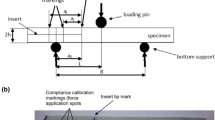Abstract
The in-plane failure envelopes of unidirectional (UD) laminae in a UD and a Triax (0°, ±45°) laminate configuration have been investigated. The two laminate configurations have been characterised by testing off-axis specimens in uniaxial tension and compression at different angles relative to the fibre direction and further by Iosipescu shear tests. Strain gauge and Digital Image Correlation (DIC) measurements were used to measure the deformation states during loading, and to record the stress-strain responses to identify the initiation of failure and investigate the heterogeneity of the material and possible parasitic effects. A novel analysis methodology to determine the so-called ‘failure initiation strength’ based on the second derivative of the stresses with respect to the strains has been adopted. The experimentally determined ‘failure initiation stresses’ were compared with predictions from the commonly applied Maximum Stress, Tsai-Wu, and Puck failure criteria. From this work, a thorough comparison of the UD and Triax failure envelopes has been facilitated. It is shown that failure prediction for the Triax laminate based on the failure envelope derived from UD lamina tests may be too conservative in comparison with fitting a failure criterion directly to the Triax laminate test data. The latter approach implies that the Triax laminate is considered as a single lamina with homogenised properties, which in principle violates the theoretical background of the considered failure criteria, since these are established to predict failure for a UD lamina. However, the simple homogenisation is shown to be a useful design oriented approach for providing a simple estimation of the onset of failure in laminate configurations composed of e.g., multiple layers of Triax. Thus, a reliable and efficient approach is offered for the structural integrity assessment, which takes the non-crimp fabric configurations directly or ‘as delivered’ into account.






















Similar content being viewed by others
References
Hinton, M., Kaddour, A., Soden, P.: A comparison of the predictive capabilities of current failure theories for composite laminates, judged against experimental evidence. Compos. Sci. Technol. 62(12), 1725–1797 (2002)
Jones, R.M.: Mechanics of Composite Materials, vol. 2. Taylor & Francis, London (1975)
Tsai, S.W.: A survey of macroscopic failure criteria for composite materials. J. Reinf. Plast. Compos. 3(1), 40–62 (1984)
Tsai, S., Wu, E.: A general theory of strength for anisotropic materials. J. Compos. Mater. 5(1), 58–80 (1971)
Puck, A., Schürmann, H.: Failure analysis of frp laminates by means of physically based phenomenological models. Compos. Sci. Technol. 58(7), 1045–1067 (1998)
Carvelli, V., Gramellini, G., Lomov, S., Bogdanovich, A., Mungalov, D., Verpoest, I.: Fatigue behavior of non-crimp 3d orthogonal weave and multi-layer plain weave e-glass reinforced composites. Compos. Sci. Technol. 70(14), 2068–2076 (2010)
Lomov, S., Bogdanovich, A., Ivanov, D., Mungalov, D., Karahan, M., Verpoest, I.: A comparative study of tensile properties of non-crimp 3d orthogonal weave and multi-layer plain weave e-glass composites. part 1: Materials, methods and principal results. CCompos. A: Appl. Sci. Manuf. 40(8), 1134–1143 (2009)
Ivanov, D., Lomov, S., Bogdanovich, A., Karahan, M., Verpoest, I.: A comparative study of tensile properties of non-crimp 3d orthogonal weave and multi-layer plain weave e-glass composites. part 2: Comprehensive experimental results. Compos. A: Appl. Sci. Manuf. 40(8), 1144–1157 (2009)
Leong, M., Overgaard, L., Daniel, I., Lund, E., Thomsen, O.: Interlaminar/interfiber failure of unidirectional glass fiber reinforced composites used for wind turbine blades. J. Compos. Mater. 47(3), 353–368 (2012)
Christensen, R.: Observations on the definition of yield stress. Acta Mech. 196(3), 239–244 (2008)
Daniel, I.: Failure of composite materials. Strain 43(1), 4–12 (2007)
Puck, A.: Festigkeitsanalyse von Faser-Matrix-Laminaten - Modelle fr die Praxis. Carl Hanser Verlag Mnchen Wien (1996)
Deuschle, H.M., Kröplin, B.-H.: Finite element implementation of Pucks failure theory for fibre-reinforced composites under three-dimensional stress. Journal of Composite Materials 46(19-20), 2485–2513 (2012)
Kaddour, A., Hinton, M.: Maturity of 3d failure criteria for fibre-reinforced composites: Comparison between theories and experiments: Part b of wwfe-ii. J. Compos. Mater. 47(6–7), 925–966 (2013)
Puck, A., Kopp, J., Knops, M.: Guidelines for the determination of the parameters in Pucks action plane strength criterion. Compos. Sci. Technol. 62(3), 371–378 (2002)
Sutton, M., Wolters, W., Peters, W., Ranson, W., McNeill, S.: Determination of displacements using an improved digital correlation method. Image Vis. Comput. 1(3), 133–139 (1983)
Chu, T., Ranson, W., Sutton, M.: Applications of digital-image-correlation techniques to experimental mechanics. Exp. Mech. 25(3), 232–244 (1985)
ASTM D5379 / D5379M - 05: Standard test method for shear properties of composite materials by the v-notched beam method. Am. Soc. Test. Mater.
ASTM D3039 / D3039M - 08: Standard test method for tensile properties of polymer matrix composite materials. Am. Soc. Test. Mater.
ASTM D695 - 10: Standard test method for compressive properties of rigid plastics. Am. Soc. Test. Mater.
Budiansky, B.: Micromechanics. Comput. Struct. 16(1), 3–12 (1983)
Budiansky, B., Fleck, N. A.: Compressive failure of fibre composites. J. Mech. Phys. Solids 41(1), 183–211 (1993)
Mouritz, A., Leong, K., Herszberg, I.: A review of the effect of stitching on the in-plane mechanical properties of fibre-reinforced polymer composites. Compos. A: Appl. Sci. Manuf. 28(12), 979–991 (1997)
Arteiro, A., Catalanotti, G., Xavier, J., Camanho, P.: Notched response of non-crimp fabric thin-ply laminates. Compos. Sci. Technol.
Acknowledgments
The work presented is part of an Industrial PhD project carried out in collaboration between Suzlon Energy A/S, Denmark and the Department of Mechanical and Manufacturing Engineering, Aalborg University, Denmark. The project has received partial sponsorship from the Danish Agency for Science, Technology and Innovation. The support is gratefully acknowledged.
Author information
Authors and Affiliations
Corresponding author
Rights and permissions
About this article
Cite this article
Laustsen, S., Lund, E., Kühlmeier, L. et al. Interfibre Failure Characterisation of Unidirectional and Triax Glass Fibre Non-Crimp Fabric Reinforced Epoxy Laminates. Appl Compos Mater 22, 51–79 (2015). https://doi.org/10.1007/s10443-014-9391-6
Received:
Accepted:
Published:
Issue Date:
DOI: https://doi.org/10.1007/s10443-014-9391-6




